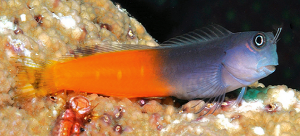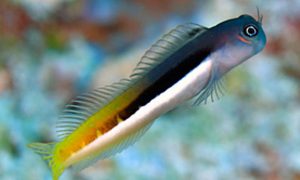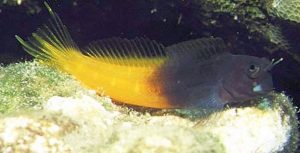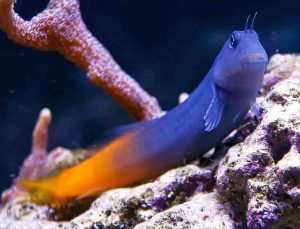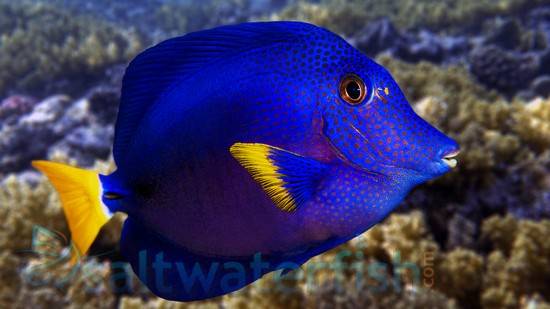The Bicolor Blenny (Ecsenius bicolor) known to tropical fish keeping enthusiasts as the Two-colored Blenny or Flame-Tail Blenny is found throughout Indo Pacific waters around Fiji, Sri Lanka, the Maldives, and Indonesia. Its range extends from the Maldives to the Phoenix Islands, north to the Ryukyu Islands, and south to the southern Great Barrier Reef; throughout Micronesia.
The Bicolor Blenny is a solitary species that inhabits the estuaries, clear lagoons, brackish seas, and seaward reefs of their range in areas of mixed corals and algae covered rocks at depths from 3 to over 80 feet where they hide among the crevices, rocks, and abandoned tubes.
The Bicolor Blenny has an elongated, eel like body shape, and an expressive face with large protruding eyes and antennae that occurs in three color phases: The bicolor phase that has a black anterior body color with a yellow posterior or a blue to dull brown anterior with a dull orange posterior.
The two other phases have black dorsal areas with a broad white lateral band and a dusky belly, and a broad lateral band with or without a yellow tail. During breeding, the males exhibit dramatic color changes that include a dark blue phase.
Males are generally larger than the less vibrantly colored females. Additionally, the anal and dorsal fins in males are
larger and more extended than in females.
The Bicolor Blenny is normally a peaceful acquisition when housed in a mature community FOWLR or reef aquarium of at least 30 gallon capacity with a sandy or coralline gravel substrate and a good amount of algae covered live rock arranged into crevices, caves, and overhangs for them to graze and hide among.
The Bicolor Blenny is considered reef safe in larger tanks but have been known to pick at the mantles of clams and fleshy large polyp stony corals when crowded or underfed. They rarely do any damage to stony corals or clams in larger reef setups.
In FOWLR tanks, they are highly competitive about their algal food source and have been known to pick at other blennies, gobies, dartfish and even other species like Royal Gramma and Bi color Angelfish that have similar color markings. Some fish that get along well with the Bicolor Blenny include tangs like the Kole Tang or Mimic Tang, Butterflyfish like the Copperband Butterflyfish, and Damselfish. Avoid Scorpionfish, groupers, lionfish, hogfish, frogfish, parrotfish, and eels like the Blue or Black Ribbon Eel that could make a meal of them.
The Bicolor Blenny has been successfully bred in an aquarium environment. Mated pairs are notorious about fighting with each other prior to breeding. Breeding is eminent when the colors in the male become more vivid and the pair disappear into a hiding spot among the porous live rock to deposit their eggs. The sticky eggs are attached to the substrate in the nest via a filamentous, adhesive pad or pedestal. Both the male and female vigorously guard the adhesive eggs until they hatch out several days later into small planktonic larvae that are often found in shallow coastal waters.
In an aquarium environment, the tiny fry should be removed to another rearing tank as soon as they are visible and fed with rotifers and phytoplankton. Daily 10% water changes are necessary until they grow out into juveniles.
In their natural environment, the Bicolor Blenny feeds on a variety of marine algae. In an aquarium environment, they will graze on the naturally occurring micro algae in the aquarium and should be offered frozen and dried foods that contain marine and blue green algae, spirulina based flake or pellet foods, and occasionally Mysis and brine shrimp. Small portions offered twice daily is recommended to keep them healthy. This species will not survive without algae.
The Bicolor Blenny (Ecsenius bicolor) is commonly available to tropical fish keeping enthusiasts as wild caught or aquacultured specimens from online retailers, wholesalers, and transhippers at very reasonable prices that vary on size and area of collection.
Prices for approximate purchase sizes: 1-1/4″ to 4″ at prices starting at $22.95 for small specimens.
Minimum Tank Size: 30 gallon (55+ gallons for pairs)
Aquarium Type: Reef or FOWLR
Care Level: Easy
Temperament: Peaceful
Aquarium Hardiness: Hardy
Water Conditions: 72-78° F, dKH 8 – 12°, pH 8.1–8.4, sg 1.021-1.023
Max size: 4″
Color Form: Blue, Orange, Black, Yellow
Diet: Herbivore
Compatibility: Reef Safe
Origin: Indo Pacific
Family: Blenniidae
Lifespan: 4 – 6 years
Aquarist Experience Level: Beginner


